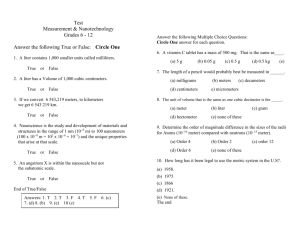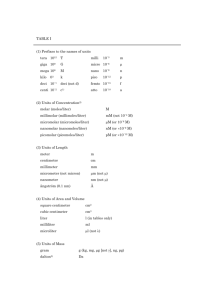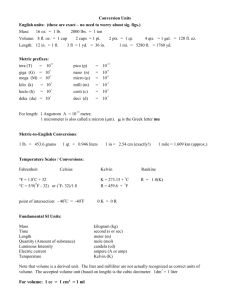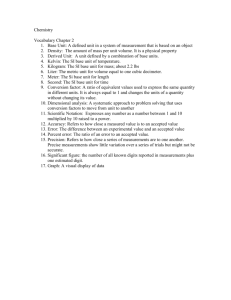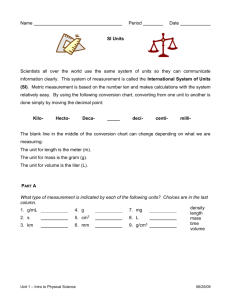Document 10510975
advertisement
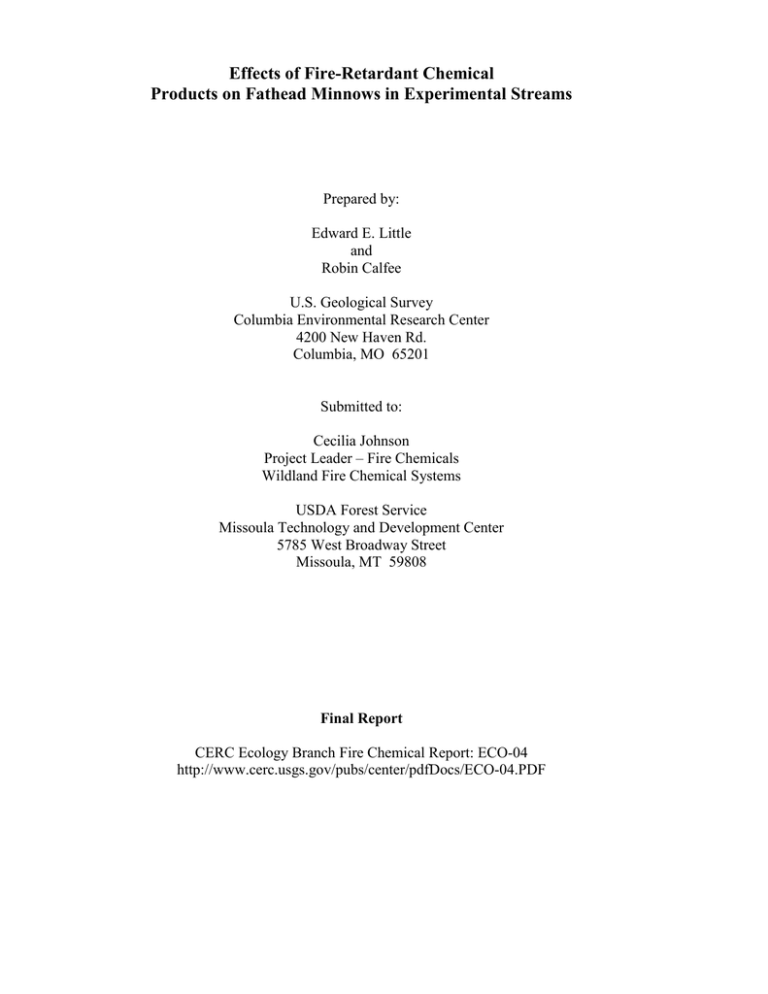
Effects of Fire-Retardant Chemical Products on Fathead Minnows in Experimental Streams Prepared by: Edward E. Little and Robin Calfee U.S. Geological Survey Columbia Environmental Research Center 4200 New Haven Rd. Columbia, MO 65201 Submitted to: Cecilia Johnson Project Leader – Fire Chemicals Wildland Fire Chemical Systems USDA Forest Service Missoula Technology and Development Center 5785 West Broadway Street Missoula, MT 59808 Final Report CERC Ecology Branch Fire Chemical Report: ECO-04 http://www.cerc.usgs.gov/pubs/center/pdfDocs/ECO-04.PDF Table of Contents EXECUTIVE SUMMARY............................................................................................... 3 INTRODUCTION............................................................................................................. 7 METHODS ........................................................................................................................ 7 TEST ORGANISMS ............................................................................................................. 7 CHEMICALS, RECEIPT, AND HANDLING............................................................................ 8 EXPERIMENTAL DESIGN AND TEST CONDITIONS .............................................................. 9 UV MEASUREMENTS ..................................................................................................... 11 CHEMICAL ANALYSIS ..................................................................................................... 12 STATISTICAL ANALYSIS ................................................................................................. 12 RESULTS......................................................................................................................... 13 CONCLUSIONS ............................................................................................................. 18 ENVIRONMENTAL IMPLICATIONS ....................................................................... 19 REFERENCES ................................................................................................................ 21 Acknowledgements We thank the staff of the Columbia Environmental Research Center for technical consultation and reviews of this report. This research was financially supported by the Forest Service Wildland Fire Chemical Systems Program. 2 EXECUTIVE SUMMARY Effects of Fire-Retardant Chemical Products to Fathead Minnows in Experimental Streams Each year large amounts of fire-retardant chemicals are applied to wildfires across the nation. The assessment of risk posed by the use of these chemicals includes understanding the toxicity of these materials relative to exposure concentrations that are likely to result from applications, the environmental persistence of the material, and surface runoff from treated watersheds. Recent laboratory studies with long-term fireretardant chemicals indicate a significant photo-enhanced toxicity of products containing sodium ferrocyanide corrosion inhibitors, with up to a 100-fold increase in toxicity to rainbow trout and a 10-fold increase in toxicity to southern leopard frogs in the presence of ultraviolet (UV) light. In contrast, compounds without this corrosion inhibitor were either unaffected in the presence of UV or exhibited a lesser additive toxicity than those containing the corrosion inhibitor. Toxicity data determined in laboratory studies of fireretardant chemicals may not accurately reflect toxicity in natural habitats because a variety of environmental variables can influence persistence as well as toxicity. Without information on toxicity in natural settings it is difficult to determine the ecological hazards and probability of injury resulting from exposure following field application of the fire-retardant chemicals. Aside from unintentional spills and overspray, stormwater runoff is a likely pathway of contamination to aquatic systems by fire-retardant chemicals. One might expect such exposures to be transient and of limited duration as the contaminated runoff is diluted and carried downstream by the water flow. In order to assess fire-chemical toxicity resulting from runoff, the fate and effects of two fire-retardant chemicals, Fire3 Trol® GTS-R (GTS-R) and Phos-Chek® D75-R (D75-R) were tested over a 24-hour period in field tests using experimental streams. (Note: The concentrations listed herein refer to milligrams of powdered concentrate mixed in one liter of water.) This investigation produced eight major results: GTS-R Exposure • Under clear sky conditions 100-percent mortality of fish exposed to a concentration of 128 milligrams GTS-R per liter of water (mg GTS-R/liter) with sodium ferrocyanide occurred within 3 hours of exposure. When fish were restocked three hours later at the same concentration, 100-percent mortality again occurred within 3 hours. At the next to the highest concentration (64 mg GTS­ R/liter), 59-percent mortality occurred after 6 hours. Survival among controls and the lowest treatment (32 mg GTS-R/liter) was 100 percent during these tests (Figure 1). • The average weak-acid-dissociable (WAD) cyanide concentration after 6 hours was 153 micrograms per liter (µg/liter) in the 128 mg GTS-R/liter test concentration, and 73 µg/liter in the 64 mg GTS-R/liter test concentration. The highest non-lethal concentration for cyanide at 6 hours was 42 µg/liter in the 32 mg GTS-R/liter test concentration (Figure 2). Surviving fish recovered rapidly as GTS-R was flushed from the streams with fresh well water and no further mortality occurred. • Although 128 mg GTS-R/liter caused 100-percent mortality under sunny conditions, no mortality occurred when the study was repeated under heavy cloud cover at similar temperatures (Figure 3). This suggests that some minimum solar UV irradiance is necessary to induce toxicity. 4 • In studies of GTS-R without sodium ferrocyanide, 100-percent survival occurred in the 128-mg GTS-R/liter treatment. This suggests that the toxicity of GTS-R is due to weak acid dissociable cyanide concentrations. • Results of our study indicate that under sunny conditions, the nonlethal concentration of GTS-R containing sodium ferrocyanide falls between 32 and 64 mg GTS-R/liter. Non-lethal concentrations of GTS-R without the corrosion inhibitor were in excess of 128 mg GTS-R/liter. D75-R Exposure • Neither mortality nor signs of behavioral distress were observed among fish exposed to D75-R at any time, even at concentrations as high as 240 mg D75R/liter. Thus lethal concentrations of D75-R are in excess of 240 mg/liter (Figure 4). • Total and un-ionized ammonia approached lethal concentrations during tests with 240 mg D75-R/liter. Un-ionized ammonia would have probably exceeded this threshold if the pH of the receiving water were greater than 8.0. • The site-specific characteristics of the watershed, including the amount of rainfall, extent of run-off, degradation of the chemical, dilution volume, and pH must be considered in determining both toxic concentrations and environmental exposure conditions for D75-R. 5 Figure 1. Percent mortality among juvenile fathead minnows exposed to GTS-R for 0 (light gray bar), 3 (dark gray bar), and 6 (black bar) hours. Each histogram represents response of three replicate exposures of 2 groups of fish. Figure 2. Observed concentrations of weak acid dissociable cyanide (µg/liter) during GTS-R exposure. The lines indicate weak-acid-dissociable (WAD) cyanide concentrations (µg/liter) after 0, 3, and 6 hours of exposure to GTS-R. Figure 3. Percent mortality among fathead minnows exposed to controls and 120 mg GTS-R/liter under heavy cloud cover and under sunny conditions. Each histogram represents two replicate exposures of two groups of test organisms. Figure 4. Percent mortality among juvenile fathead minnows exposed to GTS-R with sodium ferrocyanide (w/SF), GTS-R without sodium ferrocyanide (w/o SF), and D75-R, a fire retardant that does not contain sodium ferrocyanide. Each histogram represents two replicate exposures of two groups of 10 fish for the GTS-R tests and three replicate exposures of two groups of 10 fish for the D75-R tests. Note: significant mortality occurred only in the GTS-R treatment with sodium ferrocyanide. 6 INTRODUCTION An estimated 70 million liters of fire-retardant chemicals were used during the 2000 fire season to suppress wildland fires primarily in western regions of the United States (USDOI/DA 2000). These chemicals are often applied in relatively pristine and environmentally sensitive areas that are potentially inhabited by endangered, threatened, or sensitive aquatic species. Most fire-retardant chemicals were thought to have relatively minimal toxicity, but fish kills have been documented when these substances have been accidentally released into surface waters (Dodge 1970; Minshall and Brock 1991). Fire-retardant chemicals are generally of low toxicity to aquatic organisms, however recent laboratory studies determined that the toxicity of certain fire-retardant chemicals was heightened when exposed to UV radiation or sunlight (Little and Calfee 2000). This photo-enhanced toxicity is thought to be the result of the release of free cyanide as a result of photoactivation of sodium ferrocyanide, a corrosion inhibitor used in the Fire-Trol® GTS-R formulation. The objectives of this study were to determine the toxicity of the fireretardant chemicals Fire-Trol® GTS-R (GTS-R) and Phos-Chek® D75-R (D75-R) during exposure of fish in experimental streams. METHODS Test Organisms Juvenile fathead minnows (Pimephales promelas) were obtained from a local fish hatchery (Genesis Randolph County Fish Hatchery, Cairo, MO) and were transferred in oxygen-saturated bags to the USGS Columbia Environmental Research Center (CERC), Columbia, Missouri. Upon arrival at CERC, fish were acclimated to 25° C and kept in 7 outdoor 1200-liter tanks supplied with flowing, aerated deep well water of the same quality (pH 7.0, hardness 283 mg/L as CaCO3) as to be used in the stream studies. The fathead minnows were tested at approximately 30 to 60 days after yolk absorption. Chemicals, Receipt, and Handling Two fire-retardant chemicals, GTS-R and D75-R, were selected for testing. All fire-retardant chemicals were shipped to CERC from the U.S. Forest Service Missoula Technology and Development Center, Wildland Fire Chemical Systems (WFCS) Program (Missoula, Montana), via overnight courier in sealed 19-liter plastic containers. GTS-R formulations used during tests with and without sodium ferrocyanide were received on May 18, 1998. GTS-R and D75-R used for the other stream tests were received on September 1, 2000. Upon receipt, the shipping container was inspected for damage and the security seals were inspected for evidence of tampering. The chemicals were stored in their shipping containers at room temperature according to manufacturers’ recommendations in a secured locker at CERC. All concentrations, dilutions, and mixtures are based on the dry concentrate unless otherwise specified. The mixed retardant is prepared by mixing the qualified weight of GTS-R (1.66 pounds) or D75-R (1.20 pounds) with one expressed gallon of water. The mixed retardant is applied from aircraft or ground engines in support of wildland fire activities. The number of gallons of mixed retardant applied to 100 square feet is referred to as GPC. Field applications may range from 1 to 8 GPC. 8 Experimental Design and Test Conditions Fire retardant exposure concentrations were selected on the basis of 96-hour LC50 concentrations determined in laboratory studies (Little and Calfee, 2000). The 96hour LC50 is the concentration lethal to 50 percent of test organisms with 96 hours of exposure. The high concentration of fire-retardants used in our study was approximately 10 times the LC50 concentration for GTS-R under UV exposure (13.6 mg GTS-R/liter) and 2 times the LC50 concentration for D75-R under UV exposure (108 mg D75-R/liter) determined in laboratory tests (Little and Calfee, 2002a). A transient exposure to fireretardant chemicals in a flowing stream was anticipated as a pulse of stormwater runoff from a fire-retardant-treated watershed. The studies were conducted in experimental stream facilities at CERC as described by Fairchild et al. (1993). This study followed an incomplete randomized balanced block design (Cochran and Cox, 1957) that paired each of four concentrations of a fire-retardant chemical with each other and provided three replicate tests per concentration. Test sequence and experimental design for the stream study are shown in Table 1. The streams were 50 meters long. Each stream consisted of a V-weir headbox, and a sequence of three riffles each 10-meters long, 1-meter wide, and 10-cm deep, separated by pools that were 10meters long, 2-meters wide and 30-cm deep. The streams were lined by an inert layer of Hypalon® covered with a 10-cm layer of 1 to 4-cm diameter natural stream gravel. Well water was biologically colonized by passage through a series of earthen holding ponds. Flow rates of each stream were matched and maintained at 5-liters-per-second with the calibrated V-notch weir. Estimated 50 percent volumetric exchange time during rinsing was approximately 30 minutes. The water volumes were 8702 liters for stream 1 and 9 6671 liters for stream 2. Experimental stream systems used in this study simulate the pool and riffle habitats of first order streams, and had well-established natural communities of periphyton, macrophytes, aquatic invertebrates, mussels, crayfish, and bluegill sunfish (Figure 5). At least three fire-retardant concentrations and a control were used. These treatments bracketed a range of environmental concentrations anticipated to occur in the field. Each stream was treated with a randomly selected fire-retardant concentration. Juvenile fathead minnows were confined in groups of 10 in three 14-liter containers. The open sides of the test containers were covered with 1.0-mm mesh netting to allow stream water to flow through them. The containers were either covered with 60-percent shade cloth (high UV treatment) or polypropylene filters (low UV treatment) to provide a natural solar exposure within the range of tolerance for the fathead minnow. Solar radiation was measured using an Optronics-754® spectroradiometer with a submersible sphere (Optronic Laboratories, Orlando FL). Predetermined amounts of dry concentrate (based on stream volumes) were dissolved in 15 liters of well water, and this mixture was released over the length of the stream and allowed to recirculate through the stream for at least 60 minutes. Fish were then added to test containers in the upstream and downstream pool areas. Exposure of fish to the recirculated water continued for 6 hours, then the test waters were flushed from the streams with fresh well water for 10 to 20 hours. During the recirculating exposure time, the fish were observed at selected intervals (3 and 6-hours post dosing) for mortality and behavioral distress. If the exposure was lethal after 3 hours, then dead fish were removed and the exposure container was restocked. The fish were also observed at 10 1, 3, and 18 to 20 hours of the rinse period to determine if there was delayed toxicity. The pH, temperature, and dissolved oxygen (DO) of the stream water were measured at the onset of the exposure, at the midpoint of the exposure, at the end of the exposure, and at the conclusion of the rinse period. Water samples were also taken at these times for analysis of ammonia and weak-acid-dissociable (WAD) cyanide. The GTS-R tests were conducted from September 14 to 22, 2000 and the D75-R tests were conducted from September 26 to October 12, 2000. All tests were conducted under clear-sky conditions. Additional tests were conducted on September 20 and October 4, 2000 with GTS-R under fully overcast cloudy conditions to assess the effects of decreased solar irradiance levels on the toxicity of this chemical. UV filters were used during these tests. Limited testing was also conducted with GTS-R with and without sodium ferrocyanide in the formulation on October 6 and October 10, 2000. UV Measurements Solar radiation was measured at the water surface and underwater (approximately 10 cm) in the exposure container (with the shade cloth and polypropylene filters) to determine the intensity of UV radiation. Measurements were taken at 2:00 pm (Central Standard Time) under clear sky conditions and under heavy cloud cover (eg., solar disc not visible). A scanning spectroradiometer was used to measure intensity by wavelength at 1 nanometer (nm) intervals over the UVB (290 to 320 nm), UVA (320 to 400 nm), and visible (400 to 700 nm) wavebands. The radiometer was calibrated with a National Institute of Standards and Technology-traceable tungsten lamp and wavelength accuracy 11 and intensity were checked during the UV measurements. The UV values are reported as cumulative microWatts per square centimeter (µW/cm2). Chemical Analysis Ammonia was measured as total ammonia (NH4-N) with a Technicon II Autoanalyzer®, and recorded using the New Analyzer Program® version 2.5 (Labtronics, Guelph, Canada, 1998). The ammonia samples were analyzed using Technicon Industrial Method #329-74W (Technicon Instruments Corporation, Tarrytown, NY). Un-ionized ammonia (NH3) concentrations in each treatment were calculated using the ammonia equilibrium equation described by Emerson et al. (1975). Nitrate samples were analyzed using standard method 4500-NO3-F Automated Cadmium Reduction method (APHA, 1989). Water samples were taken to analyze for WAD cyanide and placed in 250-ml polypropylene bottles and preserved with NaOH. The samples were shipped at 4° C via overnight courier to Severn Trent Laboratories (Arvada, CO) and analyzed using standard colorimetric method 4500-CN-I (APHA, 1989). WAD cyanide is the free ionic form of cyanide that is most likely to be released by the photo-activation of sodium ferrocyanide by UV. Statistical Analysis Mortality data were arcsine and square root transformed, then analyzed by Analysis of Variance (ANOVA) to determine if toxicity resulted from chemical 12 concentration, UV treatment, duration of exposure, or their interactions. A probability level of 0.05 was selected. RESULTS The 64 and 128 mg GTS-R /liter exposure concentrations were lethal to the fathead minnows. [Note: all fire-retardant concentrations reported herein refer to dry concentrate per liter of water.] Loss of equilibrium in fish was detected in both UV treatments within an hour of exposure. At 128 mg GTS-R/liter, 100-percent mortality occurred by hour 3 of exposure under clear sky conditions (Table 2). When fish were restocked at hour 3 in streams receiving the 128 mg GTS-R/liter treatments they also died within 1 hour of exposure. No mortality occurred among fish exposed to the 32 mg GTS­ R/liter treatment. The average measured WAD cyanide was 273 µg/liter at hour 3 and 153 µg/liter at hour 6 in the 128 mg GTS-R/liter treatments. The average WAD cyanide concentration for the 64 mg GTS-R/liter treatments was 153 µg/liter at hour 3 and 73 µg/liter at hour 6 (Table 2). The WAD cyanide measured in the 32 mg GTS-R/liter treatment was 63 µg/liter at hour 3 and 42 µg/liter at hour 6. Survivors showing loss of equilibrium recovered rapidly during the freshwater flushing period and no further mortality occurred. When exposures with 128 mg GTS-R/liter were conducted in replicated studies, resident juvenile bluegill showed signs of distress, including jumping out of the streams. Resident crayfish climbed out of the water during the application of 128 mg GTS-R/liter. When exposures with 128 mg GTS-R/liter were conducted in replicated studies under heavy clouds, no mortality occurred (Table 3). Thus, a minimum solar UV 13 irradiance was necessary to induce toxicity. The concentration of WAD cyanide in the High UV treatment was 130 µg/liter under sunny conditions, but below detection limits under cloudy conditions. When replicated studies were conducted with GTS-R formulations with and without sodium ferrocyanide under sunny sky conditions, there was 100-percent survival among fish exposed to the formulation without sodium ferrocyanide, and 100-percent mortality among fish exposed to the formulation with sodium ferrocyanide (Table 4). Neither mortality nor signs of behavioral distress, such as a loss of equilibrium were observed among fish exposed to D75-R, including concentrations as high as 240 mg D75-R/liter (Table 5). Cyanide was not detected in the control treatments, in treatments of the GTS-R formulations without sodium ferrocyanide (Table 4), or the D75-R treatments (Table 5). Under sunny conditions, UVB levels of 1.6 and 6.9 µW/cm2 (65 and 129 µW/cm2 UVA) were recorded in the low and high UV treatments, relative to a surface irradiance of 143 µW/cm2 (3233 µW/cm2 UVA). Under overcast conditions UVB irradiance was 0.1 and 3.5 µW/cm2 (3 and 95 µW/cm2 UVA) relative to a surface UVB irradiance of 39.7 µW/cm2 (948 µW/cm2 UVA). Total ammonia and un-ionized ammonia concentrations observed during the GTS­ R experiments remained within the sublethal range for all concentrations tested (Table 2). Temperature ranged from 19.2 to 25.5o C, and pH ranged from 7.4 to 7.7 during the GTS­ R tests (Table 1). Total ammonia and un-ionized ammonia concentrations approached lethal concentrations at the highest concentration of D75-R (Table 5). Temperature ranged from 16.3 to 19o C and pH ranged from 7.6 to 7.8 during the D75-R tests (Table 14 1). The temperature and pH values were within the range of tolerance for the fathead minnow. DISCUSSION Information about environmental concentrations of fire-retardant chemicals is mainly limited to recommended application rates (1 to 8 GPC). Actual applications may exceed recommended amounts depending on the judgment of the Incident Commander or, in the case of prescribed burns, the Fire Management Officer. Aqueous concentrations of GTS-R and D75-R applied in our study (32 to 128 mg GTS-R/liter, or 60 to 240 mg D75-R/liter) were considerably below the minimum concentration of mixed retardants that are typically applied during aerial application (1 GPC). The high concentration of fire-retardants used in our study was approximately 10 times the LC50 concentration of GTS-R to fathead minnows under UV exposure (13.6 mg GTS-R/liter) and 2 times the LC50 concentration for D75-R under UV exposure (108 mg D75-R/liter) determined in laboratory tests (Little and Calfee, 2002a). For GTS-R, this concentration was lethal to all test organisms within 3 hours of exposure under high solar irradiance conditions and was also lethal to organisms restocked after three hours. The observed toxicity of the 64-mg GTS-R/liter treatment was consistent with results from a 96-hour pond enclosure study in which LC50 values ranged from 21.1 to 70.8 mg GTS-R/liter under various UV and sediment treatment conditions (Little and Calfee, 2002b). Exposures in flowing streams will vary with the rate of flow as the fire-retardant is diluted and removed from the stream segment. Fish exhibiting loss of equilibrium during initial exposure to lethal GTS-R treatments rapidly recovered when placed in 15 uncontaminated water; thus, recovery occurs when duration of exposure is limited. The 3- and 6-hour exposures in the present study likely reflect worst-case scenarios. In test exposures of the Little Humbolt River (Nevada), Poulton (1997) found that Phos-Chek D75-F, a formulation nearly identical to D75-R, persisted at lethal concentrations for about 45 to 60 minutes. There are several potentially toxic components in the GTS-R formulation, including total ammonia, un-ionized ammonia, and cyanide. Total ammonia and un­ ionized ammonia remained well below lethal concentrations. In contrast, cyanide concentrations (> 73 to 273 µg/liter) measured in the 64- and 128-mg GTS-R/liter treatments were lethal at 3 and 6 hours of exposure. The observed cyanide concentrations are comparable with 96-hour LC50 values of 50 µg/liter WAD cyanide (in 13.6 mg GTS-R/liter) determined for juvenile fathead minnows (Little and Calfee, 2002a). The role of sodium ferrocyanide in the toxicity of the GTS-R formulation is clearly indicated by the total lack of mortality observed during tests of the formulation that did not contain sodium ferrocyanide. The importance of sunlight in the photoactivation of sodium ferrocyanide is also suggested by the lack of mortality during tests of the full formulation under the UV–limited conditions of heavy cloud cover. The formation of free cyanide from sodium ferrocyanide by ultraviolet radiation is a well-known reaction (Burdick and Lipschuetz, 1950). This photo-transformation takes place in the water column and is a function of UV irradiance levels. In our study, stream irradiance conditions under cloudy conditions of 40 µW/cm2 UVB and 948 µW/cm2 UVA were likely insufficient for photo-transformation, compared to irradiance levels of 143 µW/cm2 16 UVB and 3233 µW/cm2 UVA under sunny conditions. Photo-transformation likely took place throughout the stream, but not in the exposure chambers where UV was limited by filters. A number of factors will influence photo-enhanced toxicity in natural habitats. Solar angle associated with time of day, season, air pollution, clouds, and surface reflection will influence UV irradiance levels (Little and Fabacher, 1996). Water quality (especially humic acid concentration) will limit the amount of UV penetrating the water column (Scully and Lean, 1994) and may also influence the bioavailability of chemical substances to an organism by binding them (Oris et al., 1990). Mortality observed during the stream exposure was consistent with previous studies. In pond enclosure studies (Little and Calfee, 2002b), the effects of ultraviolet radiation were clearly apparent as heightened mortality occurred over a concentration range of 25 to 128 mg GTS-R/liter under the high irradiance condition, and by the rapid depletion of cyanide after 24 hours. In contrast, under low UV irradiance conditions only the highest treatment was lethal within 24 hours and cyanide was persistent for at least 4 days (Little and Calfee, 2002b). In laboratory studies of GTS-R, free cyanide concentrations in water ranged from below detections limits under dark control (foilwrapped chambers) conditions up to 22 µg/liter under UV irradiance conditions (Little and Calfee, 2000). A rapid onset of mortality within 1 to 2 hours of the onset of exposure was also observed during the laboratory tests. Preliminary results of weathering studies under ambient summer conditions indicate that GTS-R may persist in the environment for at least 21 days and possibly longer (Little and Calfee, 2002a). Runoff from treated watersheds could remain toxic 17 well after the application of the chemical. Similarly, toxic levels of D75-R remained constant after application on soils (Little and Calfee, 2002a). With both retardant chemicals, soil composition will likely be an important variable in persistence and long term hazards. Poulton (1997) found that chemical half-life of GTS-R and D75-F decreased as clay content of soils increased, with the most rapid degradation occurring in silty clay loam having a 7.5 percent organic content. D75-R was essentially nontoxic during the stream exposure and toxicity of this retardant was not increased in the presence of sunlight. In the pond enclosure studies mortality was not consistently induced during a 4-day exposure to D75-R (Little and Calfee, 2002b). D75-R does not contain the ferrocyanide corrosion inhibitor in its formulation and photo-enhanced toxicity was not apparent. Mortality in the pond enclosure study was largely associated with heightened concentrations of un-ionized ammonia, particularly as pH increased with algal growth. During the stream tests un­ ionized ammonia approached lethal levels in the 240-mg D75-R/liter treatment, but circumneutral pH levels limited un-ionized ammonia to a sublethal range. The pH of receiving waters is likely to be critical to the toxicity of D75-R. CONCLUSIONS The GTS-R formulation containing sodium ferrocyanide was toxic under sunny conditions. Toxicity occurred at concentrations of GTS-R similar to those concentrations that were toxic during pond enclosure and laboratory tests. Whether such applications constitute environmental harm depends upon the characteristics of the watershed, particularly the watershed to surface water ratio, as well as the rate of GTS-R 18 decomposition. Rainwater runoff following applications of this formulation at the recommended rate could result in lethal concentrations in small ponds and in streams receiving limited flow. Larger aquatic systems would likely dilute the formulation to sublethal levels but could have lethal effects at source points. Preliminary results of weathering studies under ambient summer conditions indicate that GTS-R may persist in the environment for at least 45 days, and possibly longer; therefore, delayed effects could occur well after the application of the chemical. Toxicity of GTS-R and D75-R from un-ionized ammonia may be of concern at the highest concentrations tested if pH is elevated (greater than pH 8) and buffering capacity is limited in the receiving waters. ENVIRONMENTAL IMPLICATIONS If 5 cm of rain fell on the area treated with the minimum recommended application rate of 1 GPC, 755 grams of GTS-R would be contained in 474 liters of water. This would result in a dilution of the retardant to a final concentration of 1.6 grams GTS-R/liter of water, an amount 47 times greater than the sublethal concentration of 34 mg GTS-R/liter observed during the stream tests. The rapid recovery of fish when removed from exposure indicates that the duration of exposure and hence the residence time of the chemical in the habitat is a critical variable. The 3- to 6-hour exposures conducted in this study probably reflect worse case situations. Depending on the flow rate of the stream, the duration of exposure may be much shorter than the 3- to 6-hour exposures of the present study, and probably not sufficient to cause harm. 19 If 5 cm of rain fell on the area treated with the minimum recommended application rate of 1 GPC, 554 grams of D75-R would be contained in 474 liters of water. The resulting concentration would be about 1.2-grams D75-R/ liter, or 10 times the highest D75-R concentration used in this study. Since this concentration did not exhibit toxicity until 14 days of exposure, it is likely that D75-R would be washed downstream before injury occurred. 20 REFERENCES APHA (American Public Health Association), American Water Works Association and Water Pollution Control Federation. (1989). Standard Methods for the Examination of Water and Wastewater. 17th Edition. APHA, Washington, D.C. Burdick, G.E. and M. Lipschuetz. (1950). Toxicity of ferro- and ferricyanide solutions to fish and determination of the cause of mortality. Transactions of the American Fisheries Society. 78:192. Cochran, W.G. and G.M. Cox. (1957). Experimental Designs. 2nd ed. Wiley, New York. Dodge, M. (1970). Nitrate poisoning, fire retardants and fertilizers---Any connection? Journal of Range Management. 23:244-247. Emerson, K.E., R.C. Russo, R.E. Lund, and R.V. Thurston. (1975). Aqueous ammonia Equilibrium calculations: Effects of pH and temperature. Journal of the Fisheries Research Board of Canada 32:2379-2383. Fairchild, J.F., F.J. Dwyer, T.W. LaPoint, S.A. Burch and C.G. Ingersoll. (1993). Evaluation of a laboratory-generated NOEC for linear alkylbenzene sulfonate in outdoor experimental streams. Environmental Toxicology and Chemistry 12:17631775. Little, E.E. and R.D. Calfee. (2002a). Environmental persistence and toxicity of fireretardant chemicals, Fire-Trol GTS-R and Phos-Chek D75-R to fathead minnows. Report to US Forest Service. June, 2002. Little, E.E. and R.D. Calfee. (2002b). The toxicity of the fire-retardant chemicals, FireTrol GTS-R and Phos-Chek D75-R in pond enclosures. Report to US Forest Service. June, 2002. 21 Little, E.E. and R.D. Calfee. (2000). The effects of UVB radiation on the toxicity of fire-fighting chemicals. Report to U.S. Forest Service. April, 2000. Little, E.E, and D. Fabacher. (1996). Exposure of freshwater fish to simulated solar UVB radiation. In G.K. Ostrander, ed., Techniques in Aquatic Toxicology. CRC Press, Boca Raton, FL, pp. 141-158. Minshall, G.W. and J.T. Brock. (1991). Observed and anticipated effects of forest fire on Yellowstone stream ecosystems. In R.B. Keiter and M.S. Boyce, eds., Greater Yellowstone Ecosystem:Redefining America’s Wilderness Heritage. Yale University Press, New Haven, CT, pp. 123-135. Oris, J.T., Hall, A.T., and J.D. Tylka. (1990). Humic acids reduce the photo-induced toxicity of anthracene to fish and daphnia. Environmental Toxicology and Chemistry 9:575-583. Poulton, B.C. (1997). Effects of fire retardant chemicals on fish and aquatic invertebrates in aquatic ecosystems of the Great Basin. pp131-186. In S. Finger, Editor, Toxicity of Fire Retardant and Foam Suppressant Chemicals to Plant and Animal Communities. Final Report to Interagency Fire Coordination Committee, Boise, Idaho. December 15, 1997. Scully, N.M. and D.R.S. Lean. (1994). The attenuation of ultraviolet radiation in temperate lakes. Archiv Fur Hydrobiologie Beiheft 43:135-144. USDOI/DA (U.S. Departments of Interior/Agriculture). (2000). Managing The Impact of Wildfires on Communities and the Environment. A Report to the President in Response to the Wildfires of 2000. 22 Table 1. Test sequence for Fire-Trol® GTS-R and Phos-Chek® D75-R (date of test in parentheses), concentration, average temperature (standard deviation in parentheses), and pH for each test trial. GTS-R TESTS Stream 1 Test 1 (9/13/00) Test 2 (9/15/00) Test 3 (9/18/00) Test 4 (9/19/00) Test 5 (9/21/00) Test 6 (9/22/00) Stream 2 Concentration Temp pH Concentration Temp PH 64 mg/L 25.0 (4.9) 23.5 (3.3) 24.0 (4.7) 22.3 (6.0) 19.8 (3.4) 23.0 (3.8) na 0 mg/L na na 64 mg/L 7.6 64 mg/L 7.5 128 mg/L 7.4 0 mg/L 7.5 32 mg/L 25.5 (3.1) 23.5 (3.3) 24.0 (4.7) 22.0 (5.9) 19.3 (3.8) 23.0 (3.8) 32 mg/L 128 mg/L 32 mg/L 128 mg/L 0 mg/L na 7.5 7.6 7.7 7.6 D75-R TESTS Stream 1 Test 1 (9/26/00) Test 2 (9/27/00) Test 3 (10/02/00) Test 4 (10/03/00) Test 5 (10/11/00) Test 6 (10/12/00) Stream 2 Concentration Temp PH Concentration Temp PH 240 mg/L 18.8 (3.9) 18.8 (2.1) 16.3 (2.9) 16.5 (3.0) 17.5 (1.7) 16.3 (2.9) 7.8 120 mg/L 7.6 7.7 60 mg/L Na 60 mg/L Na 60 mg/L 7.8 0 mg/L 7.6 120 mg/L 19.0 (4.2) 18.8 (2.1) 16.3 (2.90 16.5 (3.0) 16.3 (2.1) 16.3 (2.9) 240 mg/L 120 mg/L 0 mg/L 240 mg/L 0 mg/L 23 7.8 na na 7.7 7.6 Table 2. Total ammonia concentration, with un-ionized ammonia concentration in parentheses, and WAD cyanide concentration (mean + standard deviation), and percent mortality of fathead minnows, after 3 and 6 hours of exposure to Fire-Trol GTS-R® with and without YPS in experimental streams (N = 3 tests per treatment; 120 fish total). GTS-R Concentration (mg/L) Total Ammonia Concentration (mg/L) Un-ionized Ammonia Concentration (mg/L) Hour 3 Hour 6 0 0 WAD Cyanide Concentration (µg/L) Percent Mortality 0 Hour 3 0.1 + 0.06 Hour 6 0.1 + 0.06 Hour 3 ND Hour 6 ND Hour 3 0 Hour 6 0 32 1.7 + 0.26 1.0 + 0.23 0 0 63 + 16.9 42 + 26.7 0 0 64 5.7 + 0.31 4.6 + 0.45 0.01 + 0.001 0.01 + 0.001 153 + 25.0 73 + 30.3 13.3 + 1.3 59 + 2.4 128 10.5 + 0.78 10.5 + 0.78 0.02 + 0.008 0.02 + 0.008 273 + 20.8 153 + 20.8 100 100 24 Table 3. Average surface UV irradiance + standard deviation, and precent fathead minnow mortality after exposure to Fire-Trol® GTS-R under clear and overcast-sky solar irradiance levels. (N = 2 tests per treatment; 80 fish total). Sky Condition Surface Cloudy High UV Low UV Sunny Surface High UV Low UV Irradiance Intensity (µW/cm) UVB UVA 3.79 948 + 5.0 + 95 3.5 95 + 0.4 + 5 0.1 3 + 0.02 + 0.3 143.0 + 4 6.9 + 0.2 3233 + 200 129 + 1.0 1.6 + 0.1 65 + 5.3 25 % Mortality GTS-R Concentration 0 mg/L 128 mg/L 0 0 0 0 0 100 0 100 Table 4. Percent fathead minnow mortality and WAD cyanide concentrations (µg/L) observed (standard deviation in parentheses) after 6 hours exposure to 128 mg/L FireTrol® GTS-R with and without sodium ferrocyanide in experimental streams. Indicates not detected. (N = 2 tests per treatment; 80 fish total). Treatment % Mortality GTS-R with sodium ferrocyanide GTS-R without sodium ferrocyanide 100 0 26 Cyanide Concentration (µg/L) 210 ± 57 ND Table 5. Total ammonia and un-ionized ammonia concentration (mean + standard deviation), WAD cyanide concentration and percent mortality of fathead minnows (mean + standard deviation) after 3 and 6 hours of exposure to Phos-Chek® D75-R in experimental streams (N = 3 tests per treatment; 120 fish total). ND indicates that concentration was below detection limits. D75-R Concentration (mg/L) Total Ammonia Concentration (mg/L) Un-ionized Ammonia Concentration (mg/L) Hour 3 Hour 6 ND ND Hour 3 0.1 + 0.01 Hour 3 0.1 + 0.01 60 0.1 + 0.07 0.2 + 0.05 ND 120 11.0 + 0.07 9.4 + 0.11 240 19.9 + 0.26 17.7 + 0.44 0 WAD Cyanide Concentration (µg/L) Percent Mortality Hour 3 ND Hour 6 ND Hour 3 0 Hour 6 0 ND ND ND 0 0 0.02 + 0.004 0.02 + 0.001 ND ND 0 0 0.04 + 0.009 0.04 + 0.008 ND ND 0 0 27 Figure 5. Diagram of experimental streams showing placement of exposure chambers and UV treatment conditions used during tests with GTS-R and D75-R. 28
